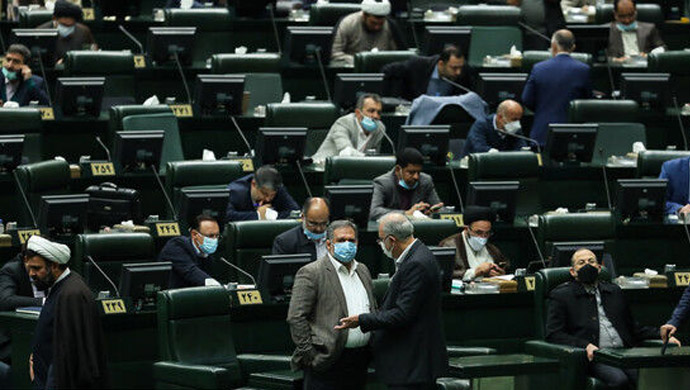As the Majlis (parliament) continues to discuss the budget bill for the upcoming Persian calendar year (starting in March), the corruption and economic crises that are intrinsic to the nature of the mullahs’ regime become more apparent. Part of the Majlis’s Sunday classified session was devoted to the discussion on the plan to eliminate the “42,000-rial exchange rate,” an issue that has become the subject of hot debate in the past months, ever since it was introduced in the budget bill.
The session was also attended by the President of the Central Bank of Iran and—ironically—the head of the Revolutionary Guards Intelligence Organization. The lawmakers deliberated on the “security implications” of removing the pegged 42,000-rial exchange rate.
The 42,000-rial exchange rate
Iran is among the few countries that has two currency exchange rates. One is the free-market rate, regulated by the supply-and-demand dynamics of the currency market. Iran’s current free-market rate stands at around 260,000 rials to the U.S. dollar.
The other is the official, government-regulated exchange rate, which has been kept pegged at 42,000 rials per USD. The official exchange rate is available in limited amounts, to specific industries and regime bodies.
For example, the 42,000-rial dollar was supposed to be made available for vital food and medicine imports to protect the price of essential goods against the wild fluctuations of the value of the rial. But the past years have seen the skyrocketing rise in the price of most basic goods, even those that are being imported at the official exchange rate.
The reason is that Iran’s economy, currency, and capital markets are controlled by corrupt regime organs such as the Revolutionary Guards, which are using their political clout to gain exclusive access to government-regulated currency and make huge profits from the difference between the official and free-market exchange rates. Much of the money that was supposed to go into subsidizing the costs of living, healthcare, and other basic needs are pocketed by corrupt organizations and officials who have absolutely no regard to the well-being of the Iranian people.
Government budget deficits
Now the Majlis is deliberating the plan to eliminate the 42,000-rial exchange rate as the government faces severe budget deficits. According to Shams Al-din Hosseini, MP and former economy minister, the government is faced with 4,000-trillion-rial budget deficit, which is around 30 percent of the total budget for the upcoming year. Other sources estimate the deficits to be double this rate.
One of the regime’s plans to cover the budget deficit is to eliminate the 42,000-rial exchange rate. Another plan is to increase the price of gasoline by removing government subsidies. Both plans have hit serious hurdles. The most immediate effect of both plans is a sudden surge in the cost of living in a country that is already faced with widespread poverty and misery.
For the moment, the gasoline price adjustment plan has been suspended because the regime fears the social repercussions arising from another price hike. In 2019, in the tripling of the price of gasoline triggered nationwide protests that pushed the regime to the brink of collapse. The fresh memories of the uprising are preventing the regime from going forward with the price increase, at least for now.
The change in currency policy can have a similar effect. Some economic experts are forecasting a six- or seven-fold increase in the price of basic goods in case the regime goes ahead with the plan. The budget bill states that the government will infuse cash into the market to control the price of goods. But if the past is any indication, such plans will end up with mass embezzlement and theft by regime officials, and a trickle of the money will actually reach the people who need it.
Conflicts of interest among regime organs
At the same time, regime institutions have a conflict of interest in these plans. The regime-linked organizations that have been profiting immensely on the margin between the official and free-market exchange rate will not want to part ways with the free money they are receiving at the expense of the people. On the other hand, the new policy provides other corrupt regime bands with new opportunities to make profits.
These conflicts of interest have triggered tension among Majlis deputies. On Monday, MP Hamidreza Haji Babaei, who opposes the plan to remove the pegged exchange rate, said, “They want to confront the Majlis with the people… The year 1401 (starting in March 2022) is the year of the people, the year of livelihoods.” In response, another MP accused Haji Babaei of trying to portray himself as a hero of the people.
Of course, the last thing that concerns the MPs and other regime officials, if at all, is the livelihoods of millions of Iranians who are living in abject poverty. The reality is that they are fighting over who gets a bigger share of the pie.
In the meantime, the government continues to face the budget deficit problem and it will have to deal with growing waves of protests by teachers, pensioners, workers, and other segments of society whose longstanding demands remain unanswered.





